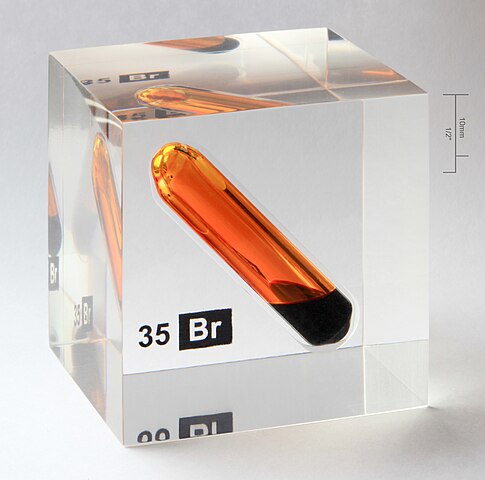Bromine is a chemical element with the symbol Br and atomic number 35. It is a volatile red-brown liquid at room temperature that evaporates readily to form a similarly coloured vapour.
Its properties are intermediate between those of chlorine and iodine.
Isolated independently by two chemists, Carl Jacob Löwig (in 1825) and Antoine Jérôme Balard (in 1826), its name was derived from the Ancient Greek βρῶμος (bromos) meaning “stench”, referring to its sharp and pungent smell.

Facts
The symbol for bromine is Br.
The atomic number for bromine is 35.
It is a volatile red-brown liquid at room temperature that evaporates to form a similarly coloured vapour.
Bromine is very reactive and thus does not occur as a native element in nature
Bromine was discovered independently by two chemists, Carl Jacob Löwig and Antoine Balard in 1825 and 1826
It is the forty-sixth most abundant element in Earth’s crust.
Bromine has two stable isotopes.
There are two known stable bromine isotopes.
The two stable isotopes are 79Br and 81Br.
79Br making up 51% of natural bromine and 81Br makes up the remaining 49%
Other bromine isotopes are all radioactive, with half-lives too short to occur in nature
Atomic weight is 79.904
The melting point for bromine is 19 °F (-7.2 °C).
Atomic number (number of protons in the nucleus): 35
Bromine is the third halogen
The name comes from the Ancient Greek bromos meaning “stench”, referring to its sharp and pungent smell.
Bromine is a nonmetal in group 17 of the periodic table.
Bromine is intermediate in reactivity between chlorine and iodine
Commercially the element is extracted from brine evaporation ponds, mostly in the United States and Israel.
Bromine is in the p-block on the periodic table of elements.
Compounds containing bromine in the -1 oxidation state are called bromides.
Along with mercury, bromine is one of two elements found to be a liquid at room temperature.
It is the forty-sixth most abundant element in Earth’s crust.
Bromine’s easy solubility means it has built up in the oceans through a process called leaching.
The Dead Sea contains 0.4% bromide ions
During the First World War, bromine compounds such as xylyl bromide were used as poison gas
The bromine industry is about one-hundredth the size of the chlorine industry
Potassium bromide, was frequently used as sedatives in the 19th and early 20th century.
The simplest compound of bromine is hydrogen bromide, HBr.
Hydrogen bromide is a colourless gas
The human body contains about 0.0004 percent bromine
Elemental bromine is toxic and causes chemical burns on human flesh.
Inhaling bromine gas results in irritation of the respiratory tract, causing coughing, choking, shortness of breath, and even death if inhaled in large enough quantities
Bromine can be used as an alternative to chlorine in swimming pools.
Bromine is transported in large-capacity metal drums or lead-lined tanks that can hold hundreds of kilograms or even tonnes of bromine
Some bromine-containing compounds were historically used as sedatives but not any more.
Bromine is used in cooling towers (in place of chlorine) for controlling bacteria, algae, fungi, and zebra mussels
Bromine can be absorbed into the body via contaminated water and food
Bromine is corrosive to human tissue in a liquid state and its vapors irritate eyes and throat. Bromine vapors are very toxic with inhalation. – source : https://www.lenntech.com/periodic/elements/br.htm
Bromine compounds can be used as flame retardants. However, the use of bromine as a flame retardant has been phased out in the USA because of toxicity concerns. – source : https://www.rsc.org/periodic-table/element/35/bromine
Tyrian purple, an expensive purple dye known to ancient civilizations, was produced from an organic bromine compound secreted from a sea mussel known as the murex. – source : https://education.jlab.org/itselemental/ele035.html
Information
| Atomic number (Z) | 35 | ||||||||||||||||||||
|---|---|---|---|---|---|---|---|---|---|---|---|---|---|---|---|---|---|---|---|---|---|
| Group | group 17 (halogens) | ||||||||||||||||||||
| Period | period 4 | ||||||||||||||||||||
| Block | p-block | ||||||||||||||||||||
| Electron configuration | [Ar] 3d10 4s2 4p5 | ||||||||||||||||||||
| Electrons per shell | 2, 8, 18, 7 | ||||||||||||||||||||
| Physical properties | |||||||||||||||||||||
| Phase at STP | liquid | ||||||||||||||||||||
| Melting point | (Br2) 265.8 K (−7.2 °C, 19 °F) | ||||||||||||||||||||
| Boiling point | (Br2) 332.0 K (58.8 °C, 137.8 °F) | ||||||||||||||||||||
| Density (near r.t.) | Br2, liquid: 3.1028 g/cm3 | ||||||||||||||||||||
| Triple point | 265.90 K, 5.8 kPa | ||||||||||||||||||||
| Critical point | 588 K, 10.34 MPa | ||||||||||||||||||||
| Heat of fusion | (Br2) 10.571 kJ/mol | ||||||||||||||||||||
| Heat of vaporisation | (Br2) 29.96 kJ/mol | ||||||||||||||||||||
| Molar heat capacity | (Br2) 75.69 J/(mol·K) | ||||||||||||||||||||
Vapour pressure
|
|||||||||||||||||||||
| Atomic properties | |||||||||||||||||||||
| Oxidation states | −1, +1, 2, +3, +4, +5, +7 (a strongly acidic oxide) | ||||||||||||||||||||
| Electronegativity | Pauling scale: 2.96 | ||||||||||||||||||||
| Ionisation energies |
|
||||||||||||||||||||
| Atomic radius | empirical: 120 pm | ||||||||||||||||||||
| Covalent radius | 120±3 pm | ||||||||||||||||||||
| Van der Waals radius | 185 pm | ||||||||||||||||||||
|
|
|||||||||||||||||||||
| Other properties | |||||||||||||||||||||
| Natural occurrence | primordial | ||||||||||||||||||||
| Crystal structure | orthorhombic | ||||||||||||||||||||
| Speed of sound | 206 m/s (at 20 °C) | ||||||||||||||||||||
| Thermal conductivity | 0.122 W/(m⋅K) | ||||||||||||||||||||
| Electrical resistivity | 7.8×1010 Ω⋅m (at 20 °C) | ||||||||||||||||||||
| Magnetic ordering | diamagnetic | ||||||||||||||||||||
| Molar magnetic susceptibility | −56.4×10−6 cm3/mol | ||||||||||||||||||||
| CAS Number | 7726-95-6 | ||||||||||||||||||||
| History | |||||||||||||||||||||
| Discovery and first isolation | Antoine Jérôme Balard and Carl Jacob Löwig (1825) | ||||||||||||||||||||
|
|||||||||||||||||||||
